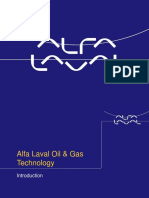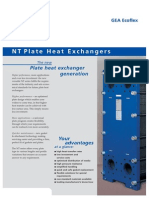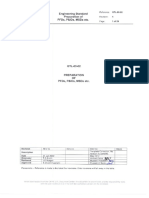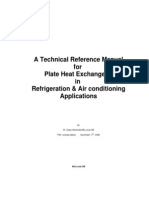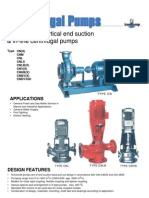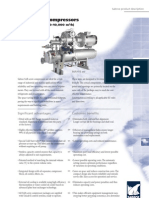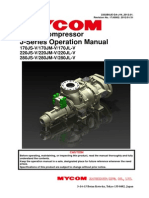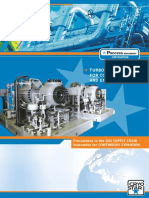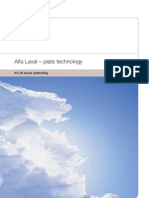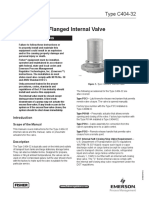Alfa Laval FACTS-8
Alfa Laval FACTS-8
Uploaded by
microco4Copyright:
Available Formats
Alfa Laval FACTS-8
Alfa Laval FACTS-8
Uploaded by
microco4Original Description:
Copyright
Available Formats
Share this document
Did you find this document useful?
Is this content inappropriate?
Copyright:
Available Formats
Alfa Laval FACTS-8
Alfa Laval FACTS-8
Uploaded by
microco4Copyright:
Available Formats
Alfa Laval Thermal
HEAT EXCHANGER
FACTS
FOR THE HEAT EXCHANGER ENGINEER
How It Works:
Special Non-Clogging
Port on the Wide-Gap
Plate Heat Exchanger
Plate Section of a Double-Sided
Wide-Gap Plate Heat Exchanger
he Alfa Laval Wide-Gap Plate Heat
Exchanger works on the same prin-
Corrugated
port edges.
ciple as the conventional PHE but
No corrugations
on port edges.
has a significantly wider flow cross section
between the plates. This feature makes it an
excellent heat exchanger to efficiently handle
fluids with a high degree of fibers or solids.
A special feature of the Wide-Gap plate is
the non-clogging port design. This unique
design offers a wide conical shaped entrance
and exit area, to-and-from each flow channel.
Edges on both inlet and outlet ports are flat
(with no corrugations). This provides a
Regular Port Design
smooth unrestricted passage for the fluid
in-and-out of each flow channel. The conical
Wide-Gap Non-Clogging
Port Design
Frame Plate
shape in the port will also minimize dead
areas between the flow channels. This is an
area on a plate where media may remain
even after draining.
VOL. 8 - 11/97 - Published three times a year.
The Wide-Gap plates can be arranged in
either double-sided or single-sided channels
with the possibility to operate fibrous media
on either one or both hot and cold sides.
Each Wide-Gap channel is always equipped
with the special non-clogging port design.
Regular Port Design at Inlet
Wide-Gap Non-Clogging Port
Design at Inlet
Basic:
Lean Liquor
Cooler
Purified Gas
Heat Exchangers In
Amine Systems
Stripper
Absorption
and Stripping
Process
Absorber
The December issue of FACTS will review gasketing and
maintenance of plate heat exchangers in Amine Systems.
Sour Gas
Heating
Medium
Process Regeneration:
Using a reboiler to drive off acid gas and some water vapor;
and a condenser to remove water vapor, the result is almost
pure acid gas. The bottom stream leaves the column and is
now Lean Amine as it has been stripped of acid gas. The
Lean Amine must be cooled before it re-enters the absorber
(colder liquids dissolve more gas). A "Feed/Bottoms" plate
heat exchanger can be used In this process.
Lean/Rich Liquor Interchanger
particles of iron sulfide (generated by attack of H2S on the
steel piping and vessels) and hydrocarbons which become
absorbed or entrained into the amine. Using a 5 micron,
full-flow sock filter will greatly reduce the amount of material
present, however, the filter may need to be replaced as
often as daily. While it is a difficult daily practice for any
operator, it would greatly eliminate fouling problems and
maintenance, regardless of the type of exchanger used.
Simultaneous heating of the Rich amine and cooling
requirements on the Lean amine call for an interchanger to
reduce energy consumption and to decrease the size of the
reboiler and Lean cooler. This exchanger can be found in all
amine systems. Because of very long thermal length
required, a shell-and-tube configuration will normally employ
three shell-and-tubes in series which are stacked. The metallurgy can be carbon steel throughout the shell-and-tubes.
Alloy is often used on the rich side components to reduce
the rate of corrosion.
Designing to ensure that the shear stress is well above
50 Pa would be the ideal way to solve the problem, as the
particle size is small and can pass through even a plate
exchanger. Obtaining this shear in a shell-and-tube is
impossible to achieve. In a plate exchanger though,
because of the high turbulence induced by corrugated
channels, this value can be achieved with a 10-15 psi drop
across the unit. Again we are faced with a problem.
Normally, the exchanger is placed on the suction side of the
lean pump. The purpose is to cool the amine below the
flash point to eliminate cavitation problems in the pump.
However, there is a nominal suction head pressure (NPSH)
which also must be satisfied. Because the head is supplied
by the liquid head of the stripping column, there is little
pressure to spare for the exchanger.
A plate exchanger can perform deep temperature crosses
in the same service in a single unit. A plate exchanger
achieves a much closer approach, thus recovering more
energy, and reducing the size of the lean cooler. Often the
lean cooler is a air-cooled exchanger because of lack of
cooling water. Reducing the size of this air cooler, can
produce a significant savings. As more heat is recovered
into the rich amine, the reboiler is reduced in size. A plate
exchanger will always be alloy, generally 316SS, and very
corrosion resistant.
In a plate exchanger, both fluids travel in like channels. Flow
rates for both fluids are very close, the difference being the
weight and volume of the dissolved acid gas. Thus pressure
drops are going to be similar.
A second possible heat exchanger is the Lean cooler. As
gas plants are often in remote locations cooling water may
not be available. Air coolers are often needed for this service. If cooling water is available, a plate exchanger is an
excellent choice, provided the operating pressure of the
lean system is within the limitations of a PHE. In gas plants,
pressures can range from low 50 psig to over 1200 psig,
depending on the gas pressure at the absorber. Alfa Laval
now produces gasketed units that can operate at 400 psig,
and welded units up to 550 psig.
While the Rich amine may be operating with more than
sufficient pressure to allow the 10-15 (0.7-1 bar) necessary
for good shear stress, it is limited by the lean side drop,
usually 3-5 psig (0.2-0.35 bar), well below that required for
good shear stress.
Moving the exchanger to the discharge side would be ideal,
however, it will be necessary to increase the height of the
column to provide enough head pressure to keep the fluid
from flashing. Many operators are not willing to do this and
you are generally stuck with a dirty design, regardless of
which exchanger type is chosen.
Design Considerations
Lean/rich amine exchangers can be extremely dirty, nearly
always on the rich side. The fouling deposit is a black waxy
substance very much like "shoe polish". Its made of fine
Phoenix Systems Uses Hastelloy Plate
Heat Exchangers To Recover Spent Acids
If its corrosive and messy and no one wants to work with it,
were the experts says Joe McDonnell, in charge of operations at Phoenix Systems in Woodburn, Oregon. Phoenix
Systems manufactures acid recycling systems for steel pickling, galvanizing, and other finishing applications.
They take supersaturated acid solutions containing hazardous materials such as zinc, chrome or nickel, and precipitate out the metals leaving rejuvinated acid for re-use. The
by-products, normally iron and zinc
sulfate, are sold as raw materials
100 F
for other processes.More importantly, the result is zero hazardous
waste and no long term liability.
Hot sulfuric acid at 160F is drawn
from operating pickling tanks and
passes through an Alfa Laval plate
heat exchanger where the hot acid
interchanges with 55F acid returning to the process. The hot acid
temperature is thus reduced to
105F. The cold, iron-free acid is
pre-heated to approximately 100F
in the plate heat exchanger before
returning to the process. Millions of
btus are recovered and several
tons of cooling is saved.
Pickling
Tank
160 F
Alfa Laval
Plate Heat
Exchanger
105 F
33 F
Chiller
55 F
Reactor
Salt to
separation
45 F
The 105F, cooled sufuric acid goes to a reactor vessel
where it is further cooled down to 55F. Salts precipitate to
the bottom and are evacuated to a settling tank; the
crystals form into a wet
slurry. The wet slurry is
pumped to a centrifuge for
liquid/crystal separation;
and the result is iron sulfate, a bluish crystal that is
resold for other applications: fertilizers, pharmaceuticals, chicken feed and
waste water treatment.
We have a greater change in temperature for precooling and preheating
than we have ever been able to maintain. Dont let the relatively small
profile of the Alfa Laval plate heat
exchanger fool you. Its incredibly
efficient. This engineering is sound.
Theyre doing a good job for us.
Joe McDonnell, President
Phoenix Systems, Inc.
Pollution Control Systems & Design
Initially shell-and-tube heat exchangers were used in their
systems until a customer recommended Alfa Laval plate
heat exchangers for their higher heat transfer rates, compact size and flexibility. Due to chlorides present in the acid
which can pit some alloys in a matter of weeks they use
plates pressed in Hastelloy Alloy C-22. This material is a
high nickel-chromium molybdenum alloy with high resistance to corrosion and oxidizing acids with chloride irons.
FROM THE PLANT
chemicals and secure at
operating temperatures above
200F compared to rubber
based cements which tend to
break-down.
Gasket Selection:
To Glue
Or Not To Glue.
Glue-Free Gaskets:
Glue-free gaskets, also called
Clip-on gaskets, should not be
used if the PHE requires service
more than once a year. More
frequent opening, closing,
power-washing and cleaning
may damage gaskets. Glue-Free
gaskets should not be used in
applications where the gasket
material is subject to chemical
attack and swelling. If a gasket
swells more than 5% due to
trace contaminants it may
stretch to a point where it no
longer fits the plate, and
must be replaced.
epending upon the application, selecting glued or
glue-free gaskets for a plate heat exchanger can
be as critical as the heat exchanger itself. Media
fouling, corrosion resistance, temperature, trace elements
of contaminants, maintenance frequency, plate metallurgy,
type of glue and how its applied (spot glued or fully glued)
to the gasket should be considered. Ignoring any one of
these factors could have catastrophic results for the heat
exchanger operation.
Glued Gaskets:
If a proper glue and gluing technique is applied to plates, a
glued gasket PHE should be able to withstand opening and
power-washing several times within its estimated gasket
service life.Glued gaskets are the best choice in high fouling services that require frequent PHE cleaning. For these
applications Alfa Laval recommends a two-part, oven-cured
epoxy: GC-6. This special adhesive is resistant to most
Glued Gasket
Glue-Free (Clip-On)
Gasket
Alfa Laval Thermal Inc. full service engineers are available
to provide expert advise on proper gasket selection for your
specific application, E-mail mark.sloan@ alfalaval.com or
call 804-236-1322.
Advantage
Disadvantage
Typical Applications
Glued Gasket
Debris can not accumulate
underneath the gasket.
Easy to power-wash on-site.
Provides extra protection against
pressure surges.
Gaskets stay-in-place even with
slight swelling.
Requires more labor to remove the
gasket and glue residue for on-site
regasketing.
Slightly higher initial cost.
Distillary, amine
interchangers,
sour water coolers,
sulfuric acid, caustic
coolers, crude oil
coolers, produced
water coolers, and
desalters.
Glue-Free
(Clip-on) Gasket
Lower initial costs.
Gaskets may be changed on the
plate while still in the frame.
Requires less time on-site to
replace the gasket.
Longer service life at higher
operating temperatures.
No special tools required to
change gaskets.
Greater risk of damage during cleaning.
Requires more time and labor to realign
the gaskets on-site after cleaning.
Gaskets must be changed if gasket
swells more than 5%.
More prone to gasket blowout with
pressure surges.
Debris can accumulate under
the gasket.
Chilled water
systems and
closed loop coolers,
sweetener
processing.
For information on Alfa Laval Heat Exchangers and plate technologies, please call your local representative
or Alfa Laval Thermal Inc., USA Headquarters, Richmond, VA: 804-236-1361 or Fax your request to
804-236-1360, attention Marketing Communications. E-mail: joan.izzo@ alfalaval.com. Visit Alfa Laval at www.alfalaval.com.
You might also like
- Plate Heat Exchanger ALFA LAVAL M3 M20Document63 pagesPlate Heat Exchanger ALFA LAVAL M3 M20Arjav Desai100% (4)
- EnppiDocument49 pagesEnppiMostafa SharafNo ratings yet
- Danfoss Catalogue - QSC Europea en 02Document675 pagesDanfoss Catalogue - QSC Europea en 02goodspeed_phNo ratings yet
- GEA Ecoflex NT Serie EDocument2 pagesGEA Ecoflex NT Serie EVLASTAR0% (1)
- Final Drawings Incl. Installation & Instruction Manual:: H2712: Hyundai Mipo Dockyard Co., Ltd. Hull No. CustomerDocument190 pagesFinal Drawings Incl. Installation & Instruction Manual:: H2712: Hyundai Mipo Dockyard Co., Ltd. Hull No. CustomerThomas Liontos100% (1)
- GTL-03-02 Rev 04 Preparation of PFD, PIDs EtcDocument29 pagesGTL-03-02 Rev 04 Preparation of PFD, PIDs EtcSaravanan VaradarajanNo ratings yet
- Carrier - AquaSnap Controls OperationDocument112 pagesCarrier - AquaSnap Controls OperationInnov8 OilNo ratings yet
- Alfa Laval Technical Manual 4thedDocument176 pagesAlfa Laval Technical Manual 4thedrararaf100% (3)
- Cryostar Process Machinery PDFDocument0 pagesCryostar Process Machinery PDFJavad AmnianNo ratings yet
- t20 Semi Welded Gasketed Plate Heat ExchangerDocument2 pagest20 Semi Welded Gasketed Plate Heat ExchangerEmersonNo ratings yet
- Alfa Laval PHE Oper. Maint. Manual1Document65 pagesAlfa Laval PHE Oper. Maint. Manual1dow2008100% (1)
- Alfa Laval Purebilge White PaperDocument14 pagesAlfa Laval Purebilge White PaperPaliwal ANo ratings yet
- HE TransterDocument16 pagesHE Transteribnuhary100% (1)
- Mdd00001en Lowres-4Document20 pagesMdd00001en Lowres-4Viajero Del Mundo100% (1)
- VSeries Grasso - Reduced PDFDocument5 pagesVSeries Grasso - Reduced PDFhonghai_dlNo ratings yet
- Instruction manual-PHE PDFDocument78 pagesInstruction manual-PHE PDFPhay Thwin Htun100% (1)
- Horizontal Split-Case Centrifugal PumpsDocument2 pagesHorizontal Split-Case Centrifugal PumpsabbasithNo ratings yet
- Alfa Laval PHE For REFDocument4 pagesAlfa Laval PHE For REFNiraj ReginaldNo ratings yet
- Alpha Laval - Phe Large Ts Frame - ImDocument21 pagesAlpha Laval - Phe Large Ts Frame - ImKaung SoeNo ratings yet
- Swep Industrial enDocument2 pagesSwep Industrial enKarol IonasNo ratings yet
- A Technical Reference Manual For Plate Heat Exchangers in Refrigeration & Air Conditioning ApplicationsDocument176 pagesA Technical Reference Manual For Plate Heat Exchangers in Refrigeration & Air Conditioning Applicationsmdalt9180No ratings yet
- SMC-Mk5 Spareparts 2022.03Document62 pagesSMC-Mk5 Spareparts 2022.03Daniel OliveraNo ratings yet
- Alfa Laval JWP - 16 Freshwater GeneratorDocument2 pagesAlfa Laval JWP - 16 Freshwater GeneratorŞcî AndreiNo ratings yet
- FW Generator Alfa LavalDocument81 pagesFW Generator Alfa LavalRusuVasileCristian100% (3)
- PHE Erection ManualDocument72 pagesPHE Erection ManualAshutosh SinghNo ratings yet
- Engineering and Maintenance - EcoFlex HeatexchangerDocument78 pagesEngineering and Maintenance - EcoFlex HeatexchangerOladipo Lawal100% (1)
- Alfa Laval JWP16CDocument4 pagesAlfa Laval JWP16CdhlinvaNo ratings yet
- CNCNLBDocument19 pagesCNCNLBRizal Falevy100% (3)
- Chemical - 2 - 0 Vahterus P S HEsDocument2 pagesChemical - 2 - 0 Vahterus P S HEsevrimkNo ratings yet
- Alfa Laval On GPHE Nov 2013Document14 pagesAlfa Laval On GPHE Nov 2013Erik Hoover100% (1)
- SAB Screw CompressorsDocument2 pagesSAB Screw CompressorsVolvouser0% (1)
- AlfaLaval Heat Transfer TheoryDocument15 pagesAlfaLaval Heat Transfer TheoryAndrés Ramón Linares100% (3)
- Plate and Frame Heat Exchanger IOMDocument28 pagesPlate and Frame Heat Exchanger IOMfrabustosNo ratings yet
- J Series ManualDocument189 pagesJ Series ManualOrlando Jose Romero Reyes100% (2)
- Alfa Laval PHE Oper. Maint. Manual1Document65 pagesAlfa Laval PHE Oper. Maint. Manual1Pamela Minero67% (3)
- Sporlan TXV Bulletin 10-91Document19 pagesSporlan TXV Bulletin 10-91seanNo ratings yet
- Comfort Handbook Alfa LavalDocument418 pagesComfort Handbook Alfa Lavalsinisamatic100% (4)
- Package Type Air ConditionerDocument20 pagesPackage Type Air ConditionerSohail Wahab100% (1)
- Parts Coalescer 01Document2 pagesParts Coalescer 01Ranjit PaulNo ratings yet
- Alfa Laval AalborgDocument8 pagesAlfa Laval AalborgZairus Fadzli Dzulkifli100% (1)
- Rotork GearboxDocument2 pagesRotork GearboxVIJIOCLNo ratings yet
- Cooling Water System Guide - 4-2429GDocument11 pagesCooling Water System Guide - 4-2429GA2 BhaskarNo ratings yet
- Brazed Plate Heat ExchangersDocument6 pagesBrazed Plate Heat ExchangersDhanielNo ratings yet
- Dresser-Rand Group Inc - FinalDocument24 pagesDresser-Rand Group Inc - FinalMatt JonesNo ratings yet
- Compresor CentrifugoDocument6 pagesCompresor Centrifugoalegria_systemsNo ratings yet
- SMC 104 106 108 InstructionManual - 2004 05 - EngDocument194 pagesSMC 104 106 108 InstructionManual - 2004 05 - Engrodrigomalvon50% (2)
- Condensing Units: Air CooledDocument12 pagesCondensing Units: Air Cooledkskr_44No ratings yet
- Wartsila Wireless Temperature MonitoringDocument3 pagesWartsila Wireless Temperature MonitoringVito DigeoNo ratings yet
- SAB 151 Engineering Service and Maintenance Manual 2014.03Document159 pagesSAB 151 Engineering Service and Maintenance Manual 2014.03nikvaanNo ratings yet
- Alfacubic - Alfa LavalDocument24 pagesAlfacubic - Alfa LavalHarmonia MSanchezNo ratings yet
- P 615 SN 4147526Document52 pagesP 615 SN 4147526Dan Alin MirceaNo ratings yet
- M15-Air Vent HeadDocument6 pagesM15-Air Vent HeadAlexNo ratings yet
- Copeland ZR125KC-TF5-950 Scroll Compressor - Carrier HVACDocument3 pagesCopeland ZR125KC-TF5-950 Scroll Compressor - Carrier HVACjacc42No ratings yet
- Turbo Expanders For Cold Production and Energy Recovery Booklet PDFDocument16 pagesTurbo Expanders For Cold Production and Energy Recovery Booklet PDFJose Luis Rodriguez LópezNo ratings yet
- Operation and Maintenance of Separators and DecantersDocument60 pagesOperation and Maintenance of Separators and DecantersTholut Zubair100% (2)
- Alfa Laval Spiral Heat Exchangers: Problem Solvers For Tough ApplicationsDocument6 pagesAlfa Laval Spiral Heat Exchangers: Problem Solvers For Tough ApplicationsRicardo Moreno RachelNo ratings yet
- Alfa Laval Spiral Heat Exchanger BrochureDocument12 pagesAlfa Laval Spiral Heat Exchanger BrochureJohn UrdanetaNo ratings yet
- Alfa Laval Plate Heat Exchangers: A Product Catalogue For Comfort Heating and CoolingDocument8 pagesAlfa Laval Plate Heat Exchangers: A Product Catalogue For Comfort Heating and CoolingvictoryanezNo ratings yet
- Spiral Heat Exchangers Preheat High Solids Black Liquor Without PluggingDocument6 pagesSpiral Heat Exchangers Preheat High Solids Black Liquor Without PluggingFelipe OrtizNo ratings yet
- Alfa Laval PHEDocument16 pagesAlfa Laval PHESergio SmithNo ratings yet
- Packinox Hydrotreating PDFDocument4 pagesPackinox Hydrotreating PDFzubair195No ratings yet
- AH AV CatalogDocument16 pagesAH AV CatalognomurapreNo ratings yet
- Meter Proving Vs TestingDocument1 pageMeter Proving Vs Testingmicroco4No ratings yet
- Siemens RTU UnitsDocument16 pagesSiemens RTU Unitsmicroco4No ratings yet
- 1823420Document11 pages1823420sri9987No ratings yet
- Proper Selection of Rupture DisksDocument6 pagesProper Selection of Rupture Disksmicroco4No ratings yet
- Fisher Internal Flow ValveDocument12 pagesFisher Internal Flow Valvemicroco4No ratings yet
- NB-18 - Specification of Rupture Disk Burst PressureDocument3 pagesNB-18 - Specification of Rupture Disk Burst Pressuremicroco4No ratings yet
- Techniques For Natural Gas SamplingDocument5 pagesTechniques For Natural Gas Samplingmicroco4No ratings yet
- 0316 - Petrochem Updates - US Refinery Capex To Stay Robust As Owners Target UpgradesDocument3 pages0316 - Petrochem Updates - US Refinery Capex To Stay Robust As Owners Target Upgradesmicroco4No ratings yet
- AG Tank Blanketing RegulatorDocument3 pagesAG Tank Blanketing Regulatormicroco4No ratings yet
- Recommended Fluid VelocityDocument1 pageRecommended Fluid Velocitymicroco4No ratings yet
- 1.7 Evaporative Air Cooling EquipmentDocument8 pages1.7 Evaporative Air Cooling EquipmentRio BananNo ratings yet
- CARRIER - Hermetic Centrifugal Chiller 19XLDocument100 pagesCARRIER - Hermetic Centrifugal Chiller 19XLDonny R Wijaya0% (1)
- Wilo Fire Fighting (NL, Miso, Asp, SCPFF) PDFDocument8 pagesWilo Fire Fighting (NL, Miso, Asp, SCPFF) PDFNabil RidwanNo ratings yet
- Amendment No. 1 January 2020 TO Is 11329: 2018 Finned Type Heat Exchanger For Room Air ConditionerDocument7 pagesAmendment No. 1 January 2020 TO Is 11329: 2018 Finned Type Heat Exchanger For Room Air ConditionerAMIT VERMA100% (1)
- Report Rafael Damar ArjanggiDocument28 pagesReport Rafael Damar ArjanggiRafael DamarNo ratings yet
- Project Report On Thermal PlantDocument58 pagesProject Report On Thermal Plantmenyu198964% (11)
- F7X SDD Manual Volume-1Document306 pagesF7X SDD Manual Volume-1韩建茂100% (2)
- Hvac Book 2009.en - Must EditDocument12 pagesHvac Book 2009.en - Must Editmiddle_inn1230No ratings yet
- Design and Control of A Cryogenic Multi-Stage Compression Refrigeration ProcessDocument8 pagesDesign and Control of A Cryogenic Multi-Stage Compression Refrigeration ProcessGezu AcuñaNo ratings yet
- D3370 Sampling Water From Closed ConduitsDocument11 pagesD3370 Sampling Water From Closed ConduitsBalas43100% (1)
- Unit 1Document25 pagesUnit 1ragavaharish463No ratings yet
- Compabloc: Customer Values Performance DataDocument35 pagesCompabloc: Customer Values Performance Datanas_mech8208No ratings yet
- Wet Bulb TemperatureDocument19 pagesWet Bulb TemperatureChemical Engg.No ratings yet
- HT Lab File D3mea2Document17 pagesHT Lab File D3mea2preetNo ratings yet
- General Requirements For Carbon and Low Alloy Steel TubesDocument10 pagesGeneral Requirements For Carbon and Low Alloy Steel TubesPaulo GalvãoNo ratings yet
- Commissioning of Combined Cycle Power PlantsDocument30 pagesCommissioning of Combined Cycle Power Plantsa_mohid1783% (6)
- DWSC - DWDC - IOM - D-EIMWC00812-14EN - Installation Manuals - EnglishDocument57 pagesDWSC - DWDC - IOM - D-EIMWC00812-14EN - Installation Manuals - Englishmshbhatti291215No ratings yet
- A Working Guide To Process Equipment ContentDocument13 pagesA Working Guide To Process Equipment ContentMichael Cabalfin50% (2)
- Shell-And-Tube Heat Exchanger Pick The Right Side ChemicaDocument3 pagesShell-And-Tube Heat Exchanger Pick The Right Side ChemicaMuhammad Hussain BilalNo ratings yet
- Assignment On Nuclear Power PlantADocument13 pagesAssignment On Nuclear Power PlantAtheunsung tale100% (1)
- A Log P/H Diagram Showing The Resulting Higher Discharge Temperature For A Larger Compression StepDocument4 pagesA Log P/H Diagram Showing The Resulting Higher Discharge Temperature For A Larger Compression StepSURESH PORUKURINo ratings yet
- Florens Insp Repair Guideline DownloadDocument96 pagesFlorens Insp Repair Guideline DownloadOscar Gabriel PinedaNo ratings yet
- SPE 108665 HP/HT Gas-Condensate Well Testing For Shell's Onyx SW ProspectDocument26 pagesSPE 108665 HP/HT Gas-Condensate Well Testing For Shell's Onyx SW ProspectTheNourEldenNo ratings yet
- Product Catalog: Koolman Air-Cooled Chiller and Heat PumpDocument16 pagesProduct Catalog: Koolman Air-Cooled Chiller and Heat PumpLEYSER ALBERTO ALVAREZ BETRUSNo ratings yet
- Scroll Compressor ALY (R-407c) SeriesDocument36 pagesScroll Compressor ALY (R-407c) SeriesAtika AnjumNo ratings yet
- Zeta Rev HP XT Technical Catalogue en Rev02Document22 pagesZeta Rev HP XT Technical Catalogue en Rev02JamesNo ratings yet
- Engine Data Sheet: CFP83-F10, F20, F30 2218 G Drive 26110 Cummins Fire Power FR - 90242, 90243Document6 pagesEngine Data Sheet: CFP83-F10, F20, F30 2218 G Drive 26110 Cummins Fire Power FR - 90242, 90243Reynaldo MarianoNo ratings yet
- Analytical Design of 1 KW Capacity Lithium Bromide/Water Absorption Refrigeration SystemDocument15 pagesAnalytical Design of 1 KW Capacity Lithium Bromide/Water Absorption Refrigeration SystemTanjim FakirNo ratings yet

